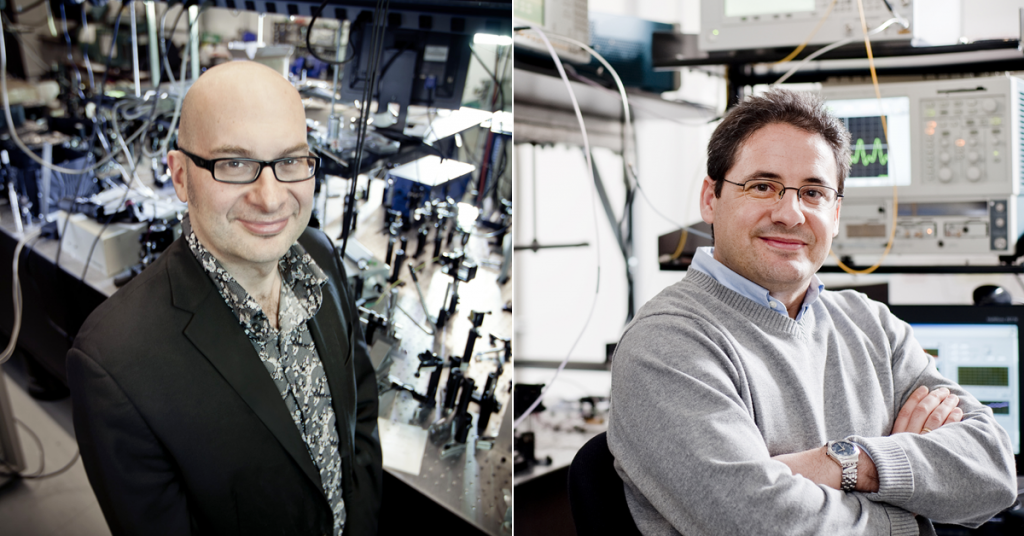- Research
The teams of Professor Roberto Morandotti and Professor José Azaña, both of INRS, made the cover of the December issue of Optics and Photonics News, the vulgarization journal of The Optical Society (OSA). This special issue looks at the year’s most important discoveries in the field.

A jury selected the most remarkable contributions from a great number of entries. The research by Professor Morandotti and Professor Azaña, presented in an article entitled “Cluster States Go High-Dimensional”, landed the cover thanks to its contribution to the development of quantum computing.
Classical computers use a binary language, where the basic unit (the bit) represents data as either 0 or 1. “On a globe, that would be the equivalent of the north and south poles,” says Professor Morandotti. “But the quantum version utilizes the entire sphere.” The quantum unit, called the qubit, can be both 0 and 1 at the same time. The value is set only when the measure is taken. For example, for a given superposition, the value would be 0 seven in ten times and 1 the rest of the time. For another superposition, it could be 0 four in ten times and 1 the rest of the time, and so forth.

The qubits Professor Morandotti used are photons linked together by the principle of quantum entanglement. Since these light particles do not interact with the environment, they maintain their quantum state over a long period of time. Despite the advantages of photons, their use in quantum computing poses some problems. To perform a complex operation, a large number of single photons have to be simultaneously detected.
“Currently, we can detect up to ten photons at a time. That’s not enough,” says the researcher. To address this problem, Professor Morandotti’s team increased the amount of information in each photon by switching from a two-dimensional (binary) to a high-dimensional model. For example, with 4 dimensions, you could have the colours blue, red, green, and orange as your quantum “basis”. “The more colours you can assemble, the more information you can package in a single photon,” says Professor Morandotti.
To perform operations on these photons, the states have to be entangled—in other words, a change applied to one will also affect the others. In his experiment, Professor Morandotti uses photons that each contain three colours (frequencies). To make them indistinguishable, an optical chip separates the colours, address them individually, then groups them back together again. This process allowed Morandotti’s team to create the first high-dimensional (more than two) entangled state in an integrated chip. Furthermore, by adding temporal information (3 different pulses with 3 colours each), the dimension can be further increased to create complex states with special properties (cluster states), making them ideal for optical quantum processing. Remarkably, this will make it possible to transmit quantum information over long distances via optical fibres. That’s one more step towards quantum computing.
“Transmitting light through blood”
Roberto Morandotti co-authored another article published in the December issue of the OSA journal entitled “Light-guiding in red blood cell suspensions”. The discovery has to do with the behaviour of light in a diffusive medium, such as blood, where rays scatter randomly in many directions. “The classic example many have seen is when you aim a laser pointer at your finger. Your finger turns red, but the light does not effectively pass through and therefore cannot be detected,” says Professor Morandotti. By using the nonlinear properties stemming from the interaction of light and organic tissue, it is possible to prevent this diffusion. The special beam could then pass all the way through the finger. Analysis of the light signal could provide information on the medium traversed, which would be a breakthrough for medical applications. “For example, it could be useful in detecting changes in the shape of red blood cells caused by malaria,” says Professor Morandotti.




